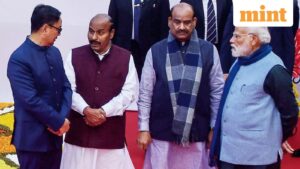At 6 p.m. on a Friday, Nidhi Menon, a 25-year-old lawyer in Mumbai, realised her wardrobe didn’t include a formal dress for a client dinner beginning in two hours. Instead of braving rush-hour traffic to the mall, she ordered her dress online, with three options. A delivery rider arrived before seven, waited while she tried them on, and left with the rejects. For Nidhi, the crisis was solved in 90 minutes; for India’s startup ecosystem, it symbolised a new frontier — fashion quick commerce.
After groceries, food, and even iPhones, style is the next category chasing instant gratification. A clutch of startups including Slikk, NEWME, Blip, Knot, and ZILO — are betting that fashion, the ultimate discretionary purchase, can be made as spontaneous as a snack order. They promise curated looks at a tap, delivered in under an hour, targeting Gen Z consumers for whom speed, trend, and convenience outrank patience.
Next wave of instant India
“India changes its distribution model every decade,” says Akshay, co-founder of Slikk, which operates out of Bengaluru. “From general trade to modern trade, to e-commerce, and now to quick commerce. Each phase starts with horizontal players, then matures into vertical specialists.”
He and his co-founders — former Amazon executives — saw grocery platforms like Zepto and Blinkit stretch their catalogues from bananas to smartphones. “The next logical vertical is fashion,” he adds. “It needs a different muscle: complex inventory, sizing, returns, and higher emotional involvement.”
That complexity, he argues, is also the moat. Horizontal delivery apps can move an iPhone; they can’t move an outfit that must fit, flatter, and express personality. Hence Slikk’s single-minded focus on fashion and lifestyle, an area Akshay calls “head-to-toe convenience.”
For NEWME, founded by four engineers led by Sumit Jasoria, the entry point was data, not design. “We are not a fashion company,” Jasoria says. “We’re a data and tech company that sells fashion.” Out of its Bengaluru base, NEWME analyses search and social signals to predict demand and drop new styles every Friday—without holding heavy inventory. Factories plug directly into its cloud platform, producing in micro-batches once demand is confirmed.
“Consumers want global trends instantly,” Jasoria says. “But building inventory means constant discounting. We designed NEWME so supply chains respond to demand, not the other way around.”
From scheduled shopping to impulse dressing
The appetite for speed stems from habit. Indians now book cabs, order food, and pay bills within seconds; waiting two days for clothes feels archaic. Fashion quick commerce attempts to collapse that gap.
“Everything from food to mobility has gone instantly—yet fashion remained scheduled,” notes Bhavik Jhaveri, co-founder and CIO of ZILO. “We saw an opportunity to simplify the question ‘What should I wear?’ through curated fashion that’s instantly accessible.”
Launched only three months ago, ZILO operates its first dark store in Mumbai, delivering within 60–90 minutes from Santacruz to Dahisar and planning to cover central Mumbai by Diwali. Its hybrid supply chain uses both dark stores and brand stores—if a product isn’t in local stock, the order is routed to a brand partner’s boutique. “It’s literally store-front to door-front in minutes,” Jhaveri says.
90-minute supply chain
To make this work, each company has reinvented its logistics playbook.
Slikk relies on micro-fulfilment centres in Bengaluru, holding fast-moving SKUs from 550 brands. Its proprietary “Try and Buy” feature sends riders with multiple sizes or colours and allows customers to test them on the spot. Riders wait 20–30 minutes, enabling instant partial returns. “Why open physical stores when we can bring the store to your doorstep?” Akshay asks.
NEWME runs two dark stores and four retail outlets in Bengaluru and a similar network in Delhi. Inventory in these outlets also feeds its 60-minute delivery arm, NEWME Zip, which now accounts for about 15–18 percent of city revenue. The company integrates store and warehouse inventory so every unit can serve both walk-ins and online buyers.
Its manufacturing cadence is extraordinary. “Every Friday we drop new styles—there’s no inventory behind them,” Jasoria says. “Within 48 hours we can predict demand on each SKU using our model. Factories see real-time purchase intent and produce accordingly. Three days later the product is on the shelf.”
ZILO, meanwhile, complements its dark-store model with “cloud stores” that host top-selling SKUs from D2C brands. Items unavailable locally are sourced from partner brand stores. This flexible model, Jhaveri says, keeps working capital light. “Fashion is a trial category; returns are behavioural. The cost of returns, not the rate, decides who wins. Our hybrid system controls that cost.”
Consumers and their carts
Unlike grocery baskets filled with daily essentials, fashion quick-commerce carts brim with aspiration. ZILO’s early data shows customers order four to five items per purchase, often assembling entire looks—tops, bottoms, accessories, even shoes. The company’s average order value is triple the vertical quick-commerce benchmark.
For NEWME, AOV hovers around ₹1,500–₹1,700 online, rising to ₹2,400 in stores. Roughly a quarter of its revenue already comes from offline outlets, but Jasoria insists physical expansion exists to strengthen hyperlocal delivery. “Stores double as mini-warehouses,” he says.
Repeat behaviour is emerging quickly. “Our repeat rate improves month-on-month,” Jhaveri says. “Top customers shop more than thrice a month.”
These shoppers skew young, urban, and image-driven. They buy for events, nights out, or simply to post a new look on Instagram. The decision cycle compresses from weeks to hours—and so must the supply chain.
Economics of instant style
Can speed and sustainability coexist? Founders insist the math can work once density improves.
ZILO, backed by $4.5 million in seed funding, aims to break even at the order level within a year. “It’s early, but our P&L is healthy given the traction,” Jhaveri says.
NEWME’s revenue jumped from ₹3.4 crore in FY22 to ₹61 crore in FY24, with burn ratios falling. “Revenue is rising faster than costs,” Jasoria claims. “We’re chasing experience, not valuation.”
Margins remain tight—delivery, reverse logistics, and packaging costs erode contribution—but rising AOVs and repeat purchases help. Slikk, for instance, sees its “try and buy” model reducing failed-fit returns that plague standard e-commerce.
The real efficiency comes from inventory turns. Because NEWME manufactures on confirmed demand, unsold stock is minimal. “If the model predicts a product will sell in 15 days, it’s sold in 17,” Jasoria says with engineer’s precision.
Competitive runway
The momentum hasn’t escaped incumbents. Myntra has rolled out its 60-minute pilot MNow; Flipkart is experimenting with “Minutes.” Traditional retailers from H&M to Lifestyle are exploring same-day fulfilment through local stores.
Akshay views this as validation. “It’s nothing but proof that we’re on the right track,” he says. “Every large distribution cycle in India ends up with two or three serious players. Competition educates consumers, reduces acquisition costs, and legitimises the category.”
Still, startups have an agility advantage. Myntra’s massive catalogue depends on third-party brands, while vertical players control curation and tech stacks end-to-end. Jasoria frames it bluntly: “Our competition isn’t Myntra or Slikk. They sell what brands supply. We create what consumers want.”
That proprietary control over design and production, he argues, is why NEWME avoids marketplaces altogether. “We don’t sell on Myntra, Ajio, or Amazon. First-party data is critical to our prediction model.”
Tier-II temptation and expansion bets
For now, Slikk is content in Bengaluru, planning to capture 20–25 percent of the city’s fashion, beauty, and lifestyle orders before expanding. “Tier-II cities aren’t far behind Tier I,” Akshay says. “In two years they’ll be ready for this model.”
ZILO’s roadmap targets Delhi and Bengaluru next year once Mumbai stabilises. NEWME, which already services most PIN codes nationally via standard delivery, plans to extend 60-minute delivery to Pune and Hyderabad. Each expects to scale through a mix of owned hubs and partner brand stores.
All three are also testing adjacent categories. Beauty and personal care fit naturally. “A customer who buys fashion also wants fragrance and skincare,” Akshay says. Jasoria, however, is cautious: “Footwear and beauty carry heavier inventory risk. We’ll add categories only when the supply chain can stay agile.”
Funding fashion’s new tempo
Investor appetite is building despite a broader slowdown in consumer tech. Several venture funds that backed grocery quick commerce are scouting its fashion cousin, lured by higher margins and the prospect of loyalty.
Jhaveri confirms active conversations. “We’re focused on perfecting Mumbai first,” he says. “But as a growing company, it’s my job to secure the runway. The right partners will help us scale responsibly.”
Analysts tracking the sector note parallels with grocery’s early phase—small order zones, high density, limited SKUs—but point out one big difference: fashion’s emotional pull and visual virality could create stronger stickiness if the experience stays seamless.
Sustainability question
Critics worry that ultra-fast fashion could amplify waste and consumption. Founders counter that data-led production cuts overstocking. NEWME’s zero-inventory model means less landfill. Slikk’s trial-first policy reduces return trips and repackaging.
“Instant fashion doesn’t have to mean disposable fashion,” says Akshay. “If we get sizing, prediction, and returns right, we can be faster and greener.”
From storefront to door-front
Back in Mumbai, Nidhi’s impromptu outfit choice has already sparked curiosity among her friends—one downloaded the same app the next morning. For the startups behind it, each such moment represents proof that impulse fashion is no longer a metropolitan quirk but a new habit in the making.
In a country where consumers once planned festive wardrobes weeks ahead, the idea of ordering a dress like dinner might seem radical. Yet, as infrastructure, algorithms, and behaviour align, it could become as ordinary as hailing a cab.
“The store has moved to the doorstep,” Akshay says. “That’s the future of fashion in India.”
Whether the 90-minute wardrobe becomes the norm or a niche convenience will depend on how efficiently these startups stitch together speed, sustainability, and scale. For now, the race is on—and the runway has never moved faster.
Published on October 13, 2025










